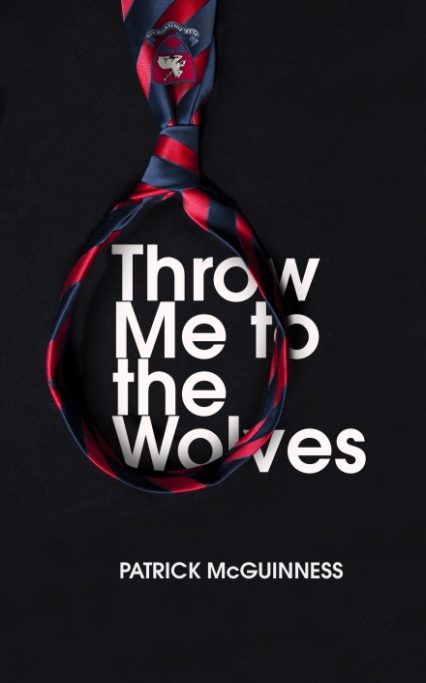Josie Cray reviews Throw Me to the Wolves, the latest novel from two-time Wales Book of the Year-winning author Patrick McGuinness.
‘You could live a whole lifetime backwards in those seconds: back to birth, as the myth goes, the dying watching their lives rewind before them.’
Following the success of his first novel The Last Hundred Days in 2011, Patrick McGuinness returns with Throw Me to the Wolves, a crime novel-cum-contemplation of memory and personal history, exploring what happens when the past seeps into the present.

Loosely based on the 2010 murder of Joanna Yeates and the media frenzy that encircled the initial subject, Throw Me to the Wolves opens in an unnamed town near Dover, home to an influential private Boys’ School, Chapleton. Days before Christmas, the body of a young woman is found in some ‘grassland just off a nameless road’. The accused, retired English teacher Michael Wolfram, is brought in for questions and becomes the catalyst for the narrator and protagonist’s reflection on the past and his lack of control over it. The police investigation unfolds interspersed with scenes from detective Alexander’s—previously Ander—childhood, focusing on his time at the local boy’s school. By examining his past and how it intertwines with the accused’s, Ander and partner, Gary, are able to solve the murder. Their interactions with the media subtly critique media practices around cases such as this, touching upon historic child abuses cases of the 1970s and 1980s and how the past, though silenced, doesn’t go anywhere: ‘it all stays’.be
Clogging the sewers below the unnamed town is an enormous fatberg— ‘the seepage of millions of fry-ups and Sunday roasts, all that pale carcass-slither’. The fatberg becomes a symbol for the coagulation of the past, described by Gary as a ‘mirror of shit’, that lies waiting for us, never really going away. Gary—a fresh take on the dim-witted sidekick—understands that the litter of our every day, our waste, the scraps of a life we wish to throw away and forget, never really goes anywhere. Instead, it coalesces into an ever-expanding blob hidden from sight—that is, until it clogs our drains, disrupting our present; what happens in the past oozes into the future.
McGuinness deploys a number of liminal locations which further the story’s contemplation of the slippery relationship between past and present. The town’s bridge which opens and closes the novel becomes a site housing those on the brink of death. Ander—or, as he is called by Gary, ‘Prof’—ruminates on the moments between jumping and hitting the water or mud below. Time might rewind and tell a different story in these moments which seems lay outside of linear time itself. The bridge is a material symbol of this in-between, an anywhere and nowhere which simply connects two destinations. The site where Zalie Dyer’s body is found, ‘an intermediate scrubland, a satnav-anonymised interzone’ where old TVs and broken fridges rest, is a place where time seems to stop. The scrubland is deemed a ‘no-place’ where nothing decays or erodes: ‘the earth refuses it all’, and so fly-tipped rubbish remains seemingly forever. Similarly, behind the boys’ school lies a crumbling zoo, now a hang-out for skateboarders and druggies where the only animals seem to be the property developers who watch it like hawks. These spaces haunt through their timelessness, existing outside of time whilst connecting the past and the present simply by their existence. They remind us how the past always remains, how memories—though susceptible to decay—can always be found in the moments in-between, wherever or whenever that is.
Although concerned with the murder of Zalie Dyer, the novel’s central concern is the treatment of boys at Chapleton and Prof’s recollection of his time there with McGuinness making a broader comment on the uncomfortable cultures fostered at boys’ schools and the historic abuses of the 1970s and 1980s; ‘we are solving something,’ Prof realises, ‘but it isn’t the murder of Zalie Dyer.’ McGuinness captures the crustiness of teachers abusing their positions of power in these school cultures. Nowhere is this more realised than in the incredibly lucid and detailed description of Mr Moreton—nicknamed ‘Morbender’ by the boys. With a face that is ‘crumbly looking’ and seemingly held together by a ‘yellowish putty’ which resembles cheese, and ‘a white paste at the corners of his mouth’ which he licks incessantly, Morbender shows how McGuinness doesn’t shy away from uncomfortable truths that have been brushed under the carpet. The teacher’s erection, ‘like a finger jabbing you in the ribs’ becomes painfully normal for young schoolboys, something Prof reflects on realising that ‘being at the bottom of the heap is having someone else define normal for you’; the normalisation of abuse allowed for its proliferation, and the mound under the carpet has become so large it has begun to trip people up.
Though much of the plot is driven by the initial murder and discovery of Zalie Dyer’s body, McGuinness does well to avoid falling into the trap of silencing women in favour of a male saviour storyline. Dyer’s online dating profile, Facebook page and other digital outlets are used not only to put the Prof and Gary on to the trail of the murderer but provide McGuinness a unique opportunity to question previous notions of the finality of death in a digital age. Messages of condolences to Dyer flood in but are never received, her dating profile still attracts new messages which will never be opened—all suggesting a digital life that is much harder to kill; ‘you’re not dead until your phone contract says so’. This digital presence is pushed further through the Prof’s niece who has a penchant for recording sounds and speech on a sound recorder and playing it back, over and over. The digital ghost returns over and over, blurring the borders of past, present, and future.
Following revelations about the murderer, Ander’s reflections on his past, ruminations on time and death, lead to clarity in his own life. After the case is solved, and after Ander puts to rest his past, he wonders: ‘what happened in Returnity, after you’ve squeezed the day?’
Seemingly stuck in a past that he can’t change, the case opens his eyes to how time, no matter what, presses on, that ‘[t]here is still time to change everything.’
Throw Me to the Wolves by Patrick McGuinness is available now in the UK through Jonathan Cape.
Josie Cray contributes regularly to Wales Arts Review.



 Enjoyed this article? Support our writers directly by buying them a coffee and clicking this link.
Enjoyed this article? Support our writers directly by buying them a coffee and clicking this link.







